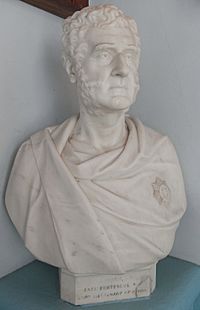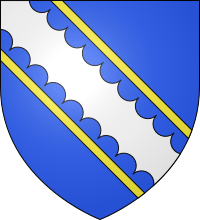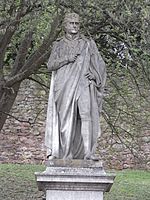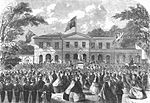Hugh Fortescue, 2nd Earl Fortescue facts for kids
Quick facts for kids
The Earl Fortescue
|
|
|---|---|

"Hugh, Earl Fortescue KG, Lord Lieutenant of Devon". Wearing Garter Star. Marble bust by Edward Bowring Stephens, 1861; Memorial Hall, West Buckland School, Devon
|
|
| Lord Lieutenant of Ireland | |
| In office 13 March 1839 – 11 September 1841 |
|
| Monarch | Victoria |
| Prime Minister | The Viscount Melbourne |
| Preceded by | The Marquess of Normanby |
| Succeeded by | The Earl de Grey |
| Personal details | |
| Born | 13 February 1783 |
| Died | 14 September 1861 (aged 78) |
| Nationality | British |
| Political party | Whig |
| Spouses | (1) Lady Susan Ryder (1796–1827) (2) Elizabeth Geale (c. 1805–1896) |
| Children | Hugh Fortescue, 3rd Earl Fortescue John Fortescue Dudley Fortescue |
| Parents | Hugh Fortescue, 1st Earl Fortescue Hester Grenville |
| Alma mater | Brasenose College, Oxford |
Hugh Fortescue, 2nd Earl Fortescue (born February 13, 1783 – died September 14, 1861), was an important British politician. He was known as Viscount Ebrington for many years. He belonged to the Whig political party. One of his most important jobs was serving as the Lord Lieutenant of Ireland from 1839 to 1841. He also helped start a school in Devon. He was made a Knight of the Garter (KG) and was part of the Privy Council (PC).
Contents
Early Life and Education
Hugh Fortescue was the oldest son of Hugh Fortescue, 1st Earl Fortescue. His mother was Hester Grenville, whose father was a Prime Minister. Hugh went to Eton College, a famous school. He then studied at Brasenose College, Oxford University.
Political Career
Hugh Fortescue, known as Ebrington at the time, became a Member of Parliament (MP) for Barnstaple when he was just 21. He served in Parliament almost continuously until 1839. At that time, he was called to the House of Lords. This happened through a special process using his father's lesser title, Baron Fortescue.
Early Political Views
When he first entered Parliament, Ebrington was part of the Whig party. This group supported the war against Napoleon. However, he later joined the "Young Whigs." This younger group was more sympathetic to the ideas of the French Revolution. They worried about how war might affect British society. Ebrington even published conversations he had with Napoleon when Napoleon was exiled.
Supporting Reform
After the war, in 1817, Ebrington became a strong supporter of political reform. He believed in making changes to the way the country was governed. He was also a religious man with an interest in economics. He strongly criticized laws known as the Six Acts. He called them "the most alarming attack" on the country's freedoms. Throughout the 1820s, he often voted for and promoted Parliamentary Reform.
The Great Reform Act
When the Whigs came to power in 1830, Ebrington played a big part in passing the Great Reform Act. This law changed how people voted and how Parliament was set up. After the House of Commons passed the bill, Ebrington gathered 100 reform-minded Whigs. He pushed for strong actions if the House of Lords rejected the bill. He even led a group that put pressure on the Whig leaders.
When the government resigned because the House of Lords refused to agree, Ebrington took the lead. He asked the House of Commons to tell the King to choose leaders who would pass the reform bill.
Later Roles
During the 1830s, Ebrington led a strong group of reformist Whigs. He also helped set up the Whig party's organization under the new voting system. In 1839, as Baron Fortescue, he became the Lord Lieutenant of Ireland. He served under Lord Melbourne. In 1841, he became the Earl Fortescue after his father passed away.
He later served as Lord Steward from 1846 to 1850 under Lord John Russell. He was made a member of the Privy Council in 1839. In 1856, he was honored as a Knight of the Garter.
Co-founding West Buckland School
In 1858, Earl Fortescue worked with Rev. J.L. Brereton to start the Devon County School. Rev. Brereton was a church leader from Exeter Cathedral. The school was built on land that Earl Fortescue donated from his estate in North Devon. This land was near West Buckland.
The school was created to give a great education to local boys. This included the sons of many farmers who rented land from him. Today, it is still known as West Buckland School. It is an independent private school. A marble statue of Earl Fortescue is on display at the school's Memorial Hall.
Family Life
Lord Fortescue was married two times.
First Marriage
- In 1817, he married Lady Susan Ryder. She passed away in 1827.
- They had three sons:
- Hugh Fortescue, 3rd Earl Fortescue (1818–1905)
- Hon. John Fortescue, who also became an MP.
- Hon. Dudley Fortescue, who also became an MP.
Second Marriage
- In 1841, 14 years after his first wife died, he married Elizabeth Geale. She passed away in May 1896.
- Elizabeth was the daughter of Piers Geale. She was also the widow of Sir Marcus Somerville, 4th Baronet.
Death and Succession
Fortescue passed away in September 1861 at the age of 78. His oldest son from his first marriage, Hugh Fortescue, 3rd Earl Fortescue, took over his title.
Images for kids
-
Hugh Fortescue, 2nd Earl Fortescue (1783–1861). Engraving by W Holl from a painting by George Hayter (1792–1871)








